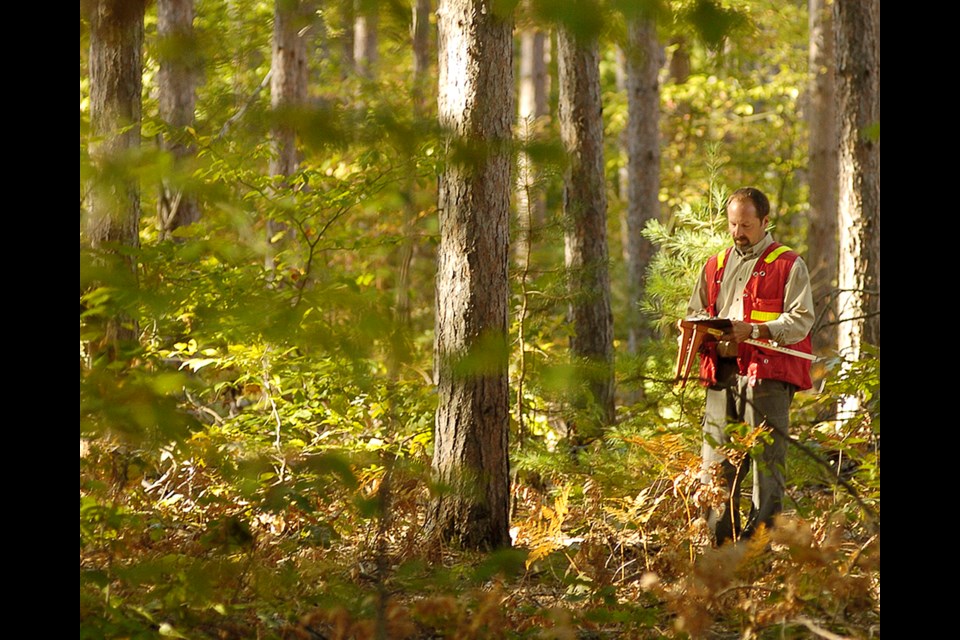Traipsing through a County of Simcoe forest is a delight, whether it’s snow or leaves crunching underfoot.
The forests are part of the oldest and largest municipal forest system in Ontario and Barrie residents can have that special connection with Mother Nature through two of the county’s forests located within the city limits.
The Blauxham Tract (93 acres) is located at the southwest corner of Salem Road and Veteran’s, while the Dyer Tract (80 acres) is located on the east side of County Road 27, north of Bear Creek Secondary School and south of Highway 90.
According to Simcoe County forester Graeme Davis, both tracts — which at one time were both in Innisfil — were purchased by the county in the 1950s.
“The Blauxham Tract was acquired in 1955,” he says. “Similar to most other tracts, it was formerly marginal agricultural land which was reforested and managed for forestry and recreation purposes.
“At the time of purchase, the Blauxham Tract was in a very rural location, approximately five kilometres south of Barrie’s city limits. In January 2010, Bill 196 came into effect adjusting the boundary of the City of Barrie and the Town of Innisfil, resulting in its inclusion within Barrie.”
It is predominantly comprised of red and white pine plantations that are more than 60 years old along with approximately 10 per cent of mixed lowland hardwood trees.
The Dyer Tract was originally 118 acres and purchased in 1954.
“This property was also within the Township of Innisfil at the time of purchase,” says Davis. “In 1999, 38 acres were sold to the Simcoe County District School Board for the construction of Bear Creek Secondary School.
“The remaining 80 acres is mixed upland hardwood species, with sugar maple and red oak dominating with many minor species including American beech, black cherry, basswood, white pine, hemlock and others,” he says. “This property is essentially an extension of the Ardagh Bluffs natural area which is owned and managed by the City of Barrie.”
Both county forests located in Barrie give residents an opportunity to get some fresh air, especially during these times of COVID, Davis adds.
“The social benefits of all county forest properties are significant and wide-ranging,” he says. “With the current situation, the importance of our residents being able to get outside, exercise and enjoy nature in a range of ways has become vital.”
Motorists travelling north on County Road 27 toward Highway 90 could easily drive past the parking area for the Dyer Tract and its tall trees and trails.
The Blauxham Tract will have a different future, however.
“The planning process for the (former Innisfil land) is now complete, culminating in portions of the tract now being designated general industrial, natural heritage, and residential,” says Davis. “The Salem Secondary Plan outlines a major collector road running north/south through the property, and a watermain is also required to follow the proposed road alignment.”
As a result, in 2017 county council directed staff to proceed with disposition of the Blauxham Tract, with the provision that all revenues be reinvested into the acquisition of additional county forest land, he adds.
“The property remains for sale at this time. It’s unusual for us to be selling any county forest property,” Davis says. “It’s not only because it is in the City of Barrie now, it’s because of where it is situated and the planning process that has transpired as a result of the Barrie secondary plan.
“With all those things in mind — the development that’s going to the area, the requirement for residential/industrial lands — it made sense to surplus that property. There will certainly be a component that will be retained as natural area (in the Blauxham Tract).”
While there are sounds from the busy, nearby roadways in both forests, the expanse of trees and hills are a welcome relief for the urbanized human, who just might want to bring a four-legged friend along. (Don’t forget to poop and scoop and dogs must be under control or on a leash.)
There are many other similar jurisdictions in Ontario which own and manage former ‘agreement forests’, Davis says.
“Many of these other municipalities and conservation authorities share similar challenges in balancing multiple values in the management of these forest lands within an increasingly urbanizing landscape,” he adds. “York Region, Dufferin County and Northumberland County share similar histories and current challenges, as do many area conservation authorities including Nottawasaga Valley and Lake Simcoe Region.”



